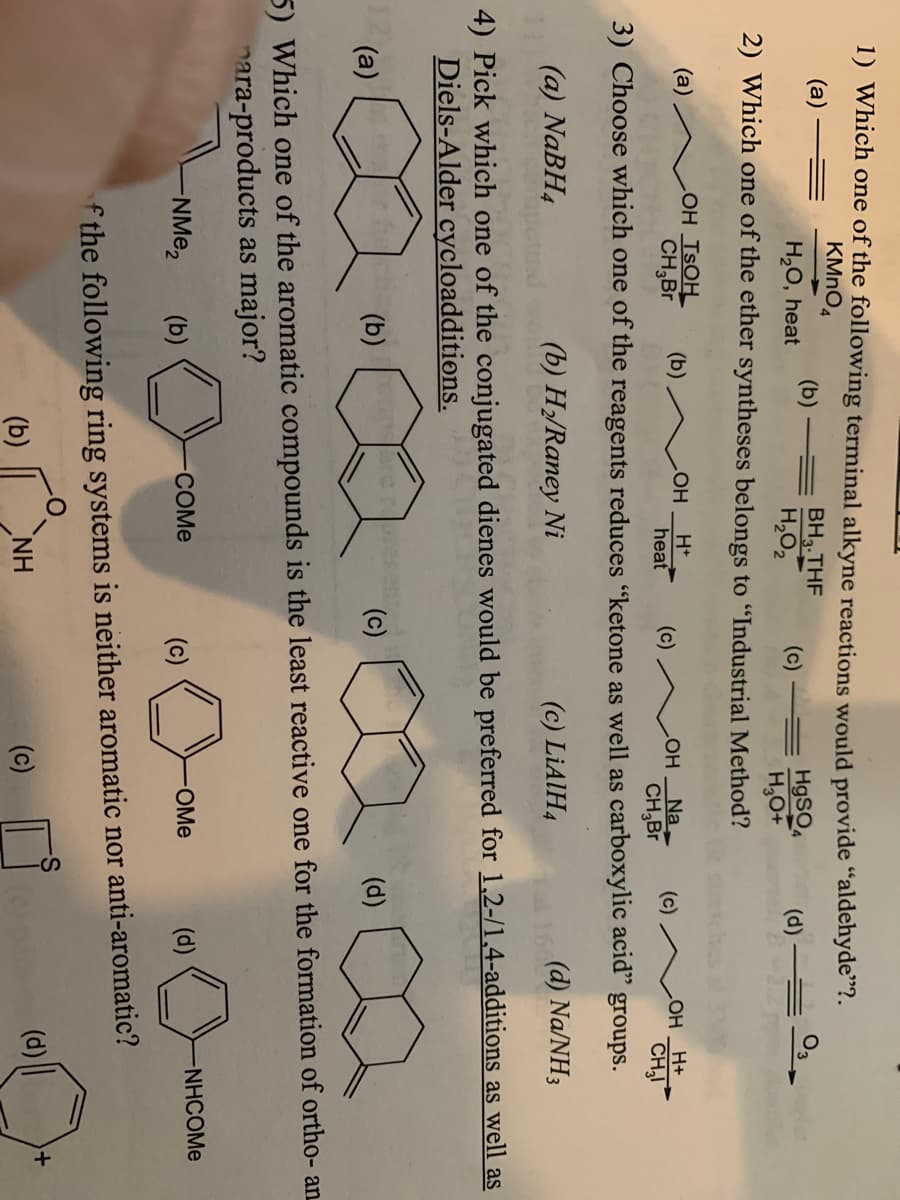1) Which one of the following terminal alkyne reactions KMnO4 (a) — (b)- H₂O, heat BH3.THF H₂O₂ (c) 2) Which one of the ether syntheses belongs to "Industria (a) OH TSOH CH3Br (b) OH H+ heat (c). 3) Choose which one of the reagents reduces "ketone as (a) NaBH4 (b) H₂/Raney Ni
1) Which one of the following terminal alkyne reactions KMnO4 (a) — (b)- H₂O, heat BH3.THF H₂O₂ (c) 2) Which one of the ether syntheses belongs to "Industria (a) OH TSOH CH3Br (b) OH H+ heat (c). 3) Choose which one of the reagents reduces "ketone as (a) NaBH4 (b) H₂/Raney Ni
Organic Chemistry
8th Edition
ISBN:9781305580350
Author:William H. Brown, Brent L. Iverson, Eric Anslyn, Christopher S. Foote
Publisher:William H. Brown, Brent L. Iverson, Eric Anslyn, Christopher S. Foote
Chapter11: Ethers, Epoxides, And Sulfides
Section: Chapter Questions
Problem 11.37P: Following are the steps in the industrial synthesis of glycerin. Provide structures for all...
Related questions
Question
Questions 1-3 please help

Transcribed Image Text:1) Which one of the following terminal alkyne reactions would provide "aldehyde”?.
KMnO4
(a)
(b)= BH3.THF
H₂O₂
H₂O, heat
03
HgSO4
(c)
=
(d)
H₂O+
2) Which one of the ether syntheses belongs to "Industrial Method?
(a)
OH TSOH
CH₂Br
(b)
OH H+
Na-
LOH
heat (c)
(c)
LOH_H+
CH₂Br
CH₂1
3) Choose which one of the reagents reduces "ketone as well as carboxylic acid" groups.
(a) NaBH4
(b) H₂/Raney Ni
(c) LiAlH4
16-(d) Na/NH3
4) Pick which one of the conjugated dienes would be preferred for 1,2-/1,4-additions as well as
Diels-Alder cycloadditions.
12(a)
(b)
represent (c)
(d)
5) Which one of the aromatic compounds is the least reactive one for the formation of ortho- an
para-products as major?
-NMe₂ (b)
-COME
NHCOMe
(c)
-OMe
(d)
of the following ring systems is neither aromatic nor anti-aromatic?
S
(b)
NH
(d)
(c)
+
Expert Solution
This question has been solved!
Explore an expertly crafted, step-by-step solution for a thorough understanding of key concepts.
Step by step
Solved in 3 steps with 3 images

Knowledge Booster
Learn more about
Need a deep-dive on the concept behind this application? Look no further. Learn more about this topic, chemistry and related others by exploring similar questions and additional content below.Recommended textbooks for you

Organic Chemistry
Chemistry
ISBN:
9781305580350
Author:
William H. Brown, Brent L. Iverson, Eric Anslyn, Christopher S. Foote
Publisher:
Cengage Learning

General, Organic, and Biological Chemistry
Chemistry
ISBN:
9781285853918
Author:
H. Stephen Stoker
Publisher:
Cengage Learning

Organic And Biological Chemistry
Chemistry
ISBN:
9781305081079
Author:
STOKER, H. Stephen (howard Stephen)
Publisher:
Cengage Learning,

Organic Chemistry
Chemistry
ISBN:
9781305580350
Author:
William H. Brown, Brent L. Iverson, Eric Anslyn, Christopher S. Foote
Publisher:
Cengage Learning

General, Organic, and Biological Chemistry
Chemistry
ISBN:
9781285853918
Author:
H. Stephen Stoker
Publisher:
Cengage Learning

Organic And Biological Chemistry
Chemistry
ISBN:
9781305081079
Author:
STOKER, H. Stephen (howard Stephen)
Publisher:
Cengage Learning,